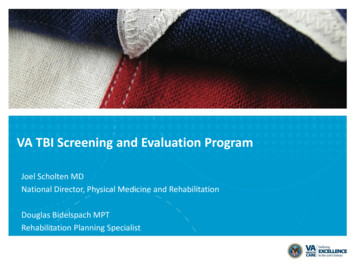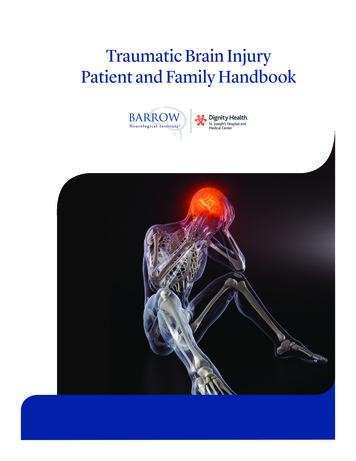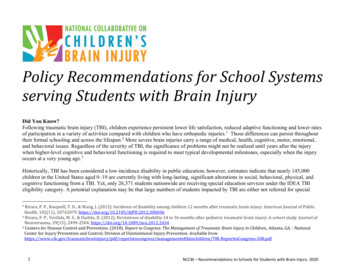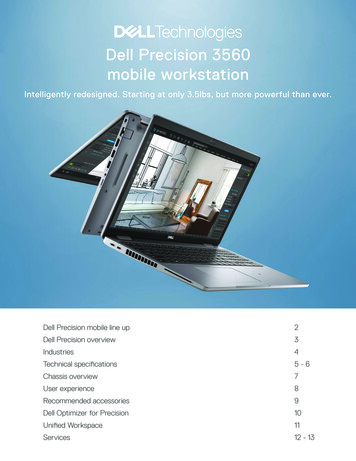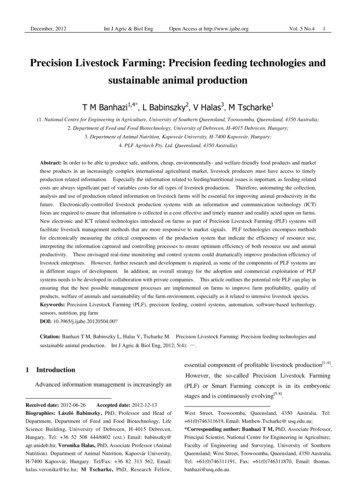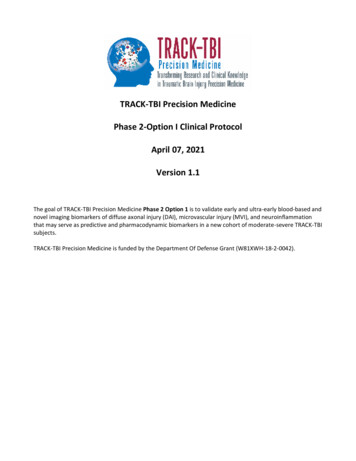
Transcription
TRACK-TBI Precision MedicinePhase 2-Option I Clinical ProtocolApril 07, 2021Version 1.1The goal of TRACK-TBI Precision Medicine Phase 2 Option 1 is to validate early and ultra-early blood-based andnovel imaging biomarkers of diffuse axonal injury (DAI), microvascular injury (MVI), and neuroinflammationthat may serve as predictive and pharmacodynamic biomarkers in a new cohort of moderate-severe TRACK-TBIsubjects.TRACK-TBI Precision Medicine is funded by the Department Of Defense Grant (W81XWH-18-2-0042).
Table of Contents1. ORIGINAL TRACK-TBI PRECISION MEDICINE GRANT SUBMISSION BACKGROUND AND STUDY OVERVIEW . 52. TRACK-TBI PRECISION MEDICINE RATIONALE, SPECIFIC AIMS, AND OBJECTIVES FROM THE ORIGINAL GRANTSUBMISSION . 52.1 Rationale . 5Table 1. Proposed TBI Biomarkers and their Relationship to TBI Mechanistic Endophenotypes . 62.2 Specific Aims . 62.3 Study Objectives . 63 STUDY DESIGN . 73.1 Participating Sites . 73.2 Participants . 73.3 Study Procedures . 7Table 2. Study Procedures . 73.4 Milestone Plan . 84 SUBJECT ELIGIBILITY . 84.1. Assessment of Eligibility . 84.2 Inclusion/Exclusion Criteria . 9Table 3. Enrollment Inclusion and Exclusion Criteria . 95 SUBJECT RECRUITMENT AND SCREENING . 105.1 Subject Identification . 105.2 Screening Process . 105.3 Participation Requirements . 10Table 4. Schedule for Follow-Up (FU) Assessment Windows . 115.4 Subject Compensation . 11Table 5. Patient Reimbursements . 116 INFORMED CONSENT . 126.1 Study Personnel Obtaining Informed Consent . 126.2 Location and Privacy . 126.3 Electronic Informed Consent (eConsent) . 126.4 Competency Screening and Legally Authorized Representatives . 126.5 Language and Literacy . 136.6 Need for Re-consent . 136.7 Storage of Consent Documents . 136.8 Waiver of Consent . 136.9 Single Institutional Review Board (sIRB) and Human Research Protections Office . 157 SUBJECT PROCEDURES BY CORE . 152
7.1 Clinical . 157.2 Biospecimens Procedures. . 16Table 6. Biospecimen Sample Collection Schedule. 16Analysis. . 167.3 Neuroimaging . 16Clinical Care Neuroimaging Acquisition . 16MRI Procedures . 17MRI Analysis . 17MRI Statistical Considerations. 177.4 Outcomes . 17Flexible Clinical Outcome Assessment (COA) Battery Framework . 18Minimizing in-person outcome assessment procedures and conducting remote outcome assessment . 18Figure 1: Flexible Outcomes Assessment Battery Framework: Decision Workflow . 198 TRACK-TBI PRECISION MEDICINE FLEXIBLE OUTCOME ASSESSMENT BATTERY AND ORDER OFADMINISTRATION . 208.1 Enrollment Battery (at consent or by phone within 24 hours of injury): 11 minutes . 208.2 Comprehensive Assessment Battery (CAB) (2 W, 6 W, 3 M) 91-108 minutes. 208.3 Abbreviated Assessment Battery (AAB) (2 W, 6 W, 3 M) 60-67 minutes . 219 TRACK-TBI PRECISION MEDICINE ASSESSMENT BATTERY: DESCRIPTION OF MEASURES . 219.1 Measures to Screen Competency and Selection of Battery . 21Speech Intelligibility . 21Galveston Orientation and Amnesia Test . 219.2 Interviews . 21Participant Interview . 219.3 Measures of Daily/Global Function . 21Functional Status Exam (FSE) . 21Glasgow Outcome Scale- Extended (GOSE) . 22Standard Assessment of Concussion (SAC) . 22Disability Rating Scale (DRS) . 229.4 Measures of Psychological Health/Neurobehavioral Symptoms . 22Brief Symptom Inventory 18 (BSI-18). 22Rivermead Post Concussion Symptoms Questionnaire (RPQ) . 22Posttraumatic Stress Disorder Checklist (PCL-5) . 22Quality of Life After Brain Injury- Overall Scale (QoLIBRI-OS). 23Columbia Suicide Severity Rating Scale (C-SSRS) Screening Version . 239.5 Measure of Symptom Validity . 23Structured Inventory of Malingered Symptomatology (SIMS) . 233
9.6 Measures of Cognitive Performance . 23Rey Auditory Verbal Learning Test (RAVLT) . 23Trail Making Test . 23Wechsler Adult Intelligence Scale – 4th Edition Processing Speed Index (WAIS-IV) PSI . 239.7 Measures of Motor Function . 24Finger tapping. 24Short physical performance battery (SPPB) . 259.8 Measures of Consciousness and Basic Cognition . 2610 Protocol for Sharing Outcome Data with Participants . 2611 Examiner Training and Certification Procedures . 2712 SUBJECT RISKS AND BENEFITS . 2712.1 Foreseeable Risks By Core . 2712.2 Protections Against Subject Risks . 2912.3 Certificate of Confidentiality . 3012.4 Potential Benefits of Proposed Research . 3013 SUBJECT COMPLIANCE AND RETENTION . 3114 DATA MANAGEMENT AND COMPLIANCE . 3114.1 Clinical database . 3114.2 Biospecimens . 33Biospecimens collection . 33Biospecimen Repository . 3314.3 Neuroimaging . 33Standardization of MR across sites . 33Neuroimaging Repository. 33Integration and analysis . 3415 ADVERSE EVENTS . 3415.1 Reporting Procedures . 3415.2 Other Serious Events . 3416 DATA SHARING . 3417 CLINICAL PROTOCOL MAINTENANCE. 3417.1 Protocol Modifications . 3417.2 Protocol Deviations. 3518 REFERENCES . 3619 ACRONYMS . 37Appendix 1: Neuroimaging MOP (separate study document)Appendix 2: Biospecimen MOP (separate study document)4
1. ORIGINAL TRACK-TBI PRECISION MEDICINE GRANT SUBMISSION BACKGROUND AND STUDY OVERVIEWEffective treatment of traumatic brain injury (TBI) remains one of the greatest unmet needs in public health.According to a 2006 publication, each year in the United States, at least 1.7 million people suffer TBI; it is acontributing factor in a third of all injury-related US deaths. An estimated 3.2 to 5.3 million people live with thelong-term physical, cognitive, and psychological health disabilities of TBI, with annual direct and indirect costsestimated at over 60 billion.1 More recent publications have reported an increase in these numbers.2 Recentefforts have increased our understanding of the pathophysiology of TBI; however, these advances have failedto translate into a single successful clinical trial or treatment.2 These failures are largely attributable to the factthat TBI classification approaches are blunt and have not changed in more than 3 decades. TBI patients aredivided into the crude categories of “mild”, “moderate”, and “severe”, using the Glasgow Coma Scale (GCS)3,and functional outcome is measured using the equally crude Glasgow Outcome Scale-Extended (GOSE).4 Thesesymptoms-based categories do not permit mechanistic targeting for clinical trials. Clinical research has alsobeen underpowered, hampered by lack of data standardization, and with limited multidisciplinarycollaboration. Workshops coordinated by the National Institute of Neurological Disorders and Stroke (NINDS),Department of Defense (DOD), and the National Institute on Disability, Independent Living, and RehabilitationResearch (NIDILRR) since 2007 identified the urgent need for improved TBI classification using more accuratediagnostic and outcome tools (beyond the GCS and GOSE), along with a standardized approach to datacollection. A multidisciplinary effort was launched to develop TBI Common Data Elements (TBI-CDEs). Domainsincluded clinical data, imaging, biospecimens, and outcomes.5-8In 2009, the multicenter Transforming Research and Clinical Knowledge in Traumatic Brain Injury Consortiumwas implemented to characterize the clinical, magnetic resonance imaging (MRI), and blood-based biomarkerfeatures of TBI to inform design of next-generation precision medicine clinical trials in TBI. Over the past 10 years, TRACK-TBI has been supported by NINDS, DoD, Department of Energy (DoE), the National FootballLeague, and other philanthropic and industry partners. TRACK-TBI has enrolled 3000 TBI subjects across theinjury spectrum, and controls, at 18 US Level 1 Trauma Centers. Our effort has established the world’s largestcollection of TBI imaging studies and biospecimens and our study results are already being adopted into clinicalresearch and bedside practice. The TRACK-TBI Consortium is now primed to deliver on critical military andpublic health knowledge gaps and needs: objective classification of TBI based on what we term “mechanistic”endophenotypes, e.g., diffuse axonal injury (DAI), microvascular injury (MVI), and neuroinflammation. Anendophenotype is an internal phenotype discoverable by biochemical, physiological, radiological, pathological,or other techniques, which is intermediate between a complex phenotype and the presumptive genetic orenvironmental contribution to a disease.9 Endophenotypes are quantitative, continuous variables, unlike aphenotype which is usually a binary, categorical variable. These mechanistic endophenotypes, defined byimaging and blood-based biomarkers, will direct targeted treatments based on mechanism, providing the toolsneeded for successful execution of precision medicine clinical trials. To achieve the goal of precision medicinein TBI, it is necessary to identify subgroups of TBI patients that will respond to a targeted therapy.2. TRACK-TBI PRECISION MEDICINE RATIONALE, SPECIFIC AIMS, AND OBJECTIVES FROM THE ORIGINALGRANT SUBMISSION2.1 RationaleIn Phase I of this study, we will assess putative blood-based and neuroimaging biomarkers for DAI, MVI, andneuroinflammation (Table 1). Fluid biomarkers complement imaging markers and may provide important toolsfor precision medicine clinical trials. In Phase 2 of this study, we will collect acute data (early and ultra-earlyi.e., hours-days following injury), to validate the utility of these biomarkers identified during Phase I in definingTBI mechanistic endophenotypes for use in clinical trials.5
Table 1. Proposed TBI Biomarkers and their Relationship to TBI Mechanistic Endophenotypes2.2 Specific AimsSPECIFIC AIM 1: To validate biomarkers of Diffuse Axonal Injury (DAI), Microvascular Injury (MVI), andNeuroinflammation using advanced blood-based assay platforms and imaging sequences.Study activities conducted in support of this Aim are reviewed under separate IRB protocols:University of California, San Francisco IRB # 18-26754University of Florida IRB # IRB201802961University of Pennsylvania IRB # 832422SPECIFIC AIM 2: To validate early and ultra-early blood-based and novel imaging biomarkers of DAI,MVI, and neuroinflammation that may serve as predictive and pharmacodynamic biomarkers in a newcohort of moderate-severe subjects.Study activities conducted in support of this Aim are reviewed under this IRB protocol.SPECIFIC AIM 3: Conduct a multicenter double-blind, placebo controlled exploratory clinical trialcomparing the impact of Cyclosporine A (CsA) on blood-based and imaging biomarkers of DAI, MVI,and neuroinflammation in moderate-severe TBI patients admitted to the ICU.Study activities conducted in support of this Aim will be reviewed under a separate IRB protocol.2.3 Study ObjectivesPhase 1-Base (Year 1): Validate biomarkers of Diffuse Axonal Injury (DAI), Microvascular Injury (MVI),and Neuroinflammation using advanced blood-based assay platforms and imaging sequences.Phase I-Base analyses are reviewed under a separate IRB protocol.Phase 2-Option I (Year 2): Validate early and ultra-early blood-based and novel imaging biomarkers ofDAI, MVI, and neuroinflammation that may serve as predictive and pharmacodynamic biomarkers in anew cohort of moderate-severe TRACK-TBI subjects.In Phase 2-Option 1 (study activities reviewed under this protocol), we will enroll a cohort of moderateto severe TBI subjects (N 50), stratified according to VA/DoD criteria for these injury severities throughthe existing TRACK-TBI network sites to obtain novel advanced neuroimaging and more frequentbiomarker sampling. Subjects will be assessed according to the existing TRACK-TBI outcomes protocolover 3 months.Phase 3-Option II (Year 3): Conduct a multicenter double-blind, placebo controlled exploratory clinicaltrial comparing the impact of Cyclosporine A (CsA) on blood-based and imaging biomarkers of DAI, MVI,and neuroinflammation in moderate-severe TBI patients admitted to the ICU.Phase 3-Option II will be reviewed under a separate IRB protocol.6
3 STUDY DESIGN3.1 Participating Sites1. University of California, San Francisco (UCSF)a. PI Geoffrey Manley2. University of Pittsburgh (UPitt)a. PI David Okonkwo3. University of Pennsylvania (UPenn)a. PI Ramon Diaz-Arrastia4. Medical College of Wisconsin (MCW)a. PI Michael McCrea5. University of Utaha. PI Ramesh Grandhi3.2 ParticipantsSubjects will be recruited among patients with TBI admitted to the emergency department, trauma, orneurosurgical services at 5 participating TRACK-TBI Clinical Sites. Each site has a system for identification andearly notification of potential patients who qualify for the study. The early notification system will result intimely arrival of the study coordinator or other trained study personnel, who will evaluate a participant’seligibility. Individuals notifying study personnel of potential patients may include ambulance coordinatingsystem personnel, neurosurgery residents, emergency room physicians, or other hospital personnel who arelikely to see brain injured patients shortly after their arrival.Once notified, study personnel will review the potential patient’s information and screen the patient accordingto the study inclusion and exclusion criteria (Table 3). Upon determining that the patient is potentially eligiblefor the study, consent will be obtained from the patient or the legally authorized representative (LAR)according to local IRB guidelines. If the patient is determined to have capacity to provide his or her ownconsent, the patient will be asked to provide informed consent. For participants whose LAR originally gaveconsent, an informed consent will be obtained from the participant once they have the capacity to do so.The target enrollment for this study is 50 participants.3.3 Study ProceduresTable 2. Study ProceduresStudy ProceduresScreening and EligibilityInclusion/ExclusioncriteriaInformed consentEligibility CT readingBlood collectedMRI scan*Clinical Data CollectionTRACK-TBI OutcomeEnrollment BatteryTRACK-TBI Follow –upOutcome BatteryScreening/ 6Enrollment XXXXX(X)XX(X)—MRI will be collected on either Day 1 or Day 2* Clinical Data will be collected daily until the subject is discharged from hospital7
3.4 Milestone PlanOur target follow-up rate for the 3-month duration of the study is 80%. The Clinical Core will monitor this rateat the overall study level as well as the individual site level. Women and minorities will be included.4 SUBJECT ELIGIBILITY4.1. Assessment of EligibilityWe will enroll adult patients (age 18-65y inclusive) presenting to the Emergency Department (ED) with ahistory of acute TBI as per American Congress of Rehabilitation Medicine (ACRM) Criteria, in which the patienthas sustained a traumatically induced* physiological disruption of brain function, as manifested by one of thefollowing: Any period of loss of consciousness (LOC) Any loss of memory for events (e.g., amnesia) immediately before or after the accident (PTA) Any alteration of consciousness/mental state at the time of the accident (feeling dazed, disoriented,and/or confused) (AOC) Focal neurologic deficits that may or may not be permanent* Traumatically induced includes the head being struck, the head striking an object, or the brain undergoing anacceleration/deceleration movement (e.g., whiplash) without direct external trauma to the head.Screening questions for LOCDid you have a period of time after the event when you were completely unconscious? That means you had noability to think, speak, or move and were completely unaware of the world around you.Screening questions for PTAWas there a period of time after the injury for which you have no memory? If so, how long did it take for yourmemory to return to normal or become consistent (e.g., who you saw, conversations, what you ate, etc. (Walkthem through the post-injury events if and as necessary).Screening questions for AOCRight after the event, did you feel dazed or confused or in a fog? Did you have trouble knowing where youwere or what happened to you? Did you keep asking the same question over and over? Did you insist youcould do things that you could or should not do?Suggested prioritization for AOC and LOC:1st- EMS run report2nd- Witness report3rd- ED records (if positive)4th- ParticipantIn general:AOC: should be recorded as “positive” if present in any of these sources. Only record AOC as negativeif available sources (especially the participant) state it did not occur.LOC: Subject’s recall is unreliable unless the subject explicitly states that a witness told informed thesubject that the subject was knocked out cold.PTA: Use the participant report for mild cases. Use EMS or hospital medical records for more severecases.8
4.2 Inclusion/Exclusion CriteriaTable 3 summarizes study inclusion and exclusion criteria. These criteria are informed by the experience of theTRACK-TBI U01 study, and are designed to mirror criteria appropriate for future trials of neuroprotective orneurorestorative therapies. These clinical and imaging criteria were identified through the TRACK-TBI U01study, and include select subjects with TBI who are at high risk for incomplete recovery (GOSE 8) out to 6months after injury. The criteria also exclude participants with very severe TBI who stand a low chance ofsurvival.Table 3. Enrollment Inclusion and Exclusion CriteriaCriteriaInclusion Criteria1. Age 18 – 65y inclusive2. History or evidence of TBI, according to DoD-VA criteria3. GCS 3 – 15 after resuscitation in the ED4. Cranial CT with evidence of trauma-related abnormality (i.e.,CT positive except for isolated epidural hematoma (EDH))5. Ability to undergo MRI6. Ability to obtain informed consent from participant or LAR7. Fluency in English or SpanishExclusion Criteria1. Unstable respiratory or hemodynamic status2. Evidence of penetrating brain injury3. Isolated EDH as only trauma-related CT abnormalityData SourceChart, InterviewChart, InterviewChartChartChart, InterviewInterviewInterviewChartChartChart4. Systemic traumatic injury that would preclude participation instudy, which is expected to result in long-term disability notrelated to TBI5. Evidence of serious infectious complications (sepsis,bacteremia, multilobar pneumonia)6. Acute ischemic heart disease (myocardial infarction orunstable angina)7. History of syncope or hypotension8. SBP 90 mm Hg, DBP 40 mm Hg for longer than 5minutesChart9. History or evidence of active malignancy10. History of pre-existing neurologic disorder, such asdementia, mild cognitive impairment, uncontrolled epilepsy,multiple sclerosis, strokes, brain tumors, prior severe TBI, orother disorder that may confound interpretation of MRI orneuropsychological results11
University of California, San Francisco IRB # 18-26754 University of Florida IRB # IRB201802961 University of Pennsylvania IRB # 832422 SPECIFIC AIM 2: To validate early and ultra-early blood-based and novel imaging biomarkers of DAI, MVI, and neuroinflammation that may serve as predictive and pharmacodynamic biomarkers in a new
